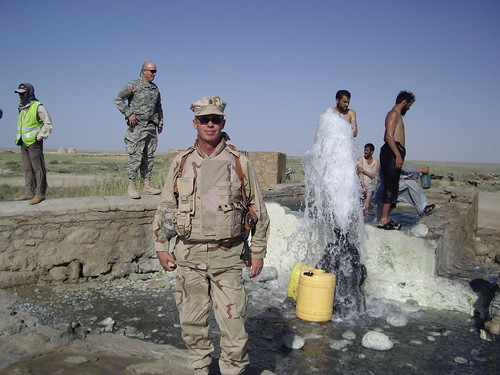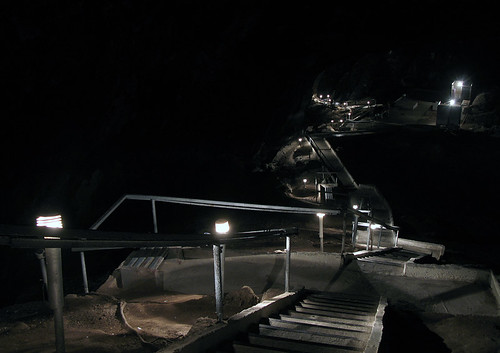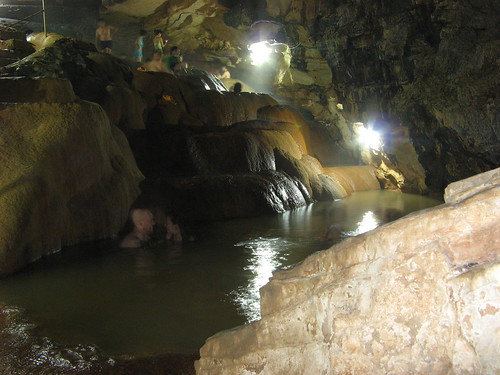Besides the many hot springs previously featured on the many entries on China, China possesses an astounding amount of hot springs scattered elsewhere in the country. What follows are just some of the more special hot springs. If you believe that a certain hot spring should be added, feel free to contact me (see sidebar).
Unfortunately this blog entry will only focus on Guangxi and Guizhou, these regions contain a number of hot springs sufficient to warrant their own blog entry ...
Guizhou and Miao custom
Though most hot soaks derive their inclusion in this chapter due to their uniqueness, the hot spring of Jianhe (Qiandongnan Miao and Dong AP, Guizhou) is here for the way in which the hot springs are enjoyed. From Chinavista.com the following:
'When the Miao drum dance performance ended, it was five o'clock in the afternoon. We took a car to the hot spring, which was 1.5 km away. It took only a short time to get there. Jianhe Hot Spring is located at the foot of a slope, surrounded by mountains on three sides and facing a flatland on one side. In 1998 Jianhe County introduced 6 million yuan of overseas investment to build a swimming pool and some auxiliary facilities at the hot springs. It opened to tourists not long ago. Every day 50-100 people come here to have a hot spring bath.
When we arrived here, local Miao People were bathing in the two pools, one for men, and the other for women. The pool for men was on the upper level. Five Miao young men were having a bath, stark naked. The pool for women was on a lower level with some having a bath and the rest washing clothes. Seeing me, the women turned their backs and said "Shame," while giggling. A young Miao man who came with me told them in their bathing and washing.
According to local tour guides, it is an ancient local custom to have a bath in hot springs, but no one knows when this custom began. For generations the Miao people have been doing just this.
Because the Miaos often have baths in hot springs, they have good skin and are strong and attractive. It seems that frequent hot spring bathing helps maintain a healthy metabolism, keep skin fair and also make you attractive as well'.
Soaking the recipe for success for the longevity?
Lizzy and Nathelie had a different experience. Dated from 2013 their visit to Jianhe is as follows:
'Natalie and I (Lizzy) were warned that the water at the hot springs was
great, but that the facilities were "backwards."
...
The Jianhe Hot Springs
were quite nice in comparison with many US hot springs. The pool was
clean and we were provided with a personal locker to store our
belongings. The changing rooms and shower rooms were overcrowded, but
that's to be expected in China'.
It seems things are changing or there have been facilities created for tourists?
The modern Jianhe? Source. Vs the traditional soak:

Reputations
Elsewhere in Guizhou province there are believed to be 18 other natural hot springs (source), while there are also 9 less natural hot springs.
Xifeng hot springs are noted for their high volumes of flow (source). Other sources of info on Xifeng can be found here, here and here.
Chelang:
'There is a hot spring on both sides of the valley in one section, and
there are ethnic houses near them. The water temperature of the hot
spring stays between 38°C and 40°C all the year round'.
Wudang district is mentioned here for having three hot springs:
'.... including the Baoli international hot spring [hotel], Guiyu hot spring and Quan Tianxia hot spring [hotel]'.
Shiqian is another town where highlighting hot springs through a festival seems commonplace. This article highlights Shiqian's Hot Spring Festival Culture and Tourism:
'It is understood that Shiqian County is located in the northeast of Guizhou is the old revolutionary base areas, when Red Army had twice been shiqian. Now in this piece of forest cover close to 48 percent of the clay on the ground, not only state-level key cultural relics Longevity Palace, as well as Chinese history and culture village upstairs Guzhai, especially the very rich in geothermal resources are currently known to the hot springs out of the dew point there are 20 of the 36 daily flow of 2.2 million metric tons, the water temperature 45 degrees Celsius, the water generally contain zinc, selenium, radon, strontium, lithium, silica and other trace elements beneficial to humans, water quality consistent with the medical mineral water standards and consistent with standards of drinking mineral water can be directly bathing, drinking, the country's unique rare in the world. Spa group in the core area of the layout of the county seat, and water resources, the largest in the country has only Shiqian, in the development and utilization of the hot springs for centuries formed a unique "hot spring culture," known as "spring city" reputation'.
There are no less than 17 hot springs in or around Shiqian (source). This website adds:
'The springs rise some distance up the mountainside, so in the old days
local officials built their bathhouse at the town's highest point in
order to get the hottest, cleanest water. Below that was the public
men's bath and, right at the bottom, the women's bath, whose water was
also used for washing clothes.
None but the oldest residents
remember this arrangement. Today the public bathhouse by the riverside
is divided into men's and women's sections, while up the hill is a
single complex housing private tubs that cost from 20 yuan to 40 yuan an
hour. It's tremendously popular with locals¡ªstreams of wet-haired
bathers accompanied me back into town along the ancient street that runs
parallel with the river'.
Another experience:
'In Shiqian, there is a hotel, build on top of the springs and to enjoy
them, you must pay the hotel for either the public bath or the private
one. Since the school was paying we went for the private one and while
there was no nature to enjoy, save for the hot spring water itself, the
experience was the most soothing I have had in China. The private room
was actually quite nice. The tub was a on the right side of the room and
was a little small, but workable. On the left side of the room was what
looked like a lay-in shallow jacuzzi, but the attendant said it didn’t
work. There was also a toilet and a stand up shower in the back of the
room and shampoo and body wash. The water that filled the tub was the
perfect temperature for me and as I stepped in I could feel all of the
noise and tension that China dumps on me on a daily basis disappearing
into the steam. I always love returning to the element I feel most at
home in, and this time there was more than ever to enjoy – the minerals,
the heat, the silence, the relief, the meditation'.
But how many are there really? This website draws attention to Sinan county, Tongren prefecture:
'The county, rich in geothermal resources, boasts 11 hot spring sites in
Yingwuxi Town, Xinglong Township, Sandaoshui Township and Tianqiao
Township, which produce 12,000 tons of spring water per day. The water
is rich in various minerals and ranges in temperature from 40°C to 58°C.
There are presently four spa resorts under development: Yingwuxi Spa
Resort, Luowantuo Spa Resort, Xinglong Spa Resort and Tianqiao Spa
Resort'.
A cave soak
West of Guizhou lies the coastal province of Guangxi which is home to one of China's most prized natural tourist destinations, Guilin.
Not far from Guilin is Yangshuo. Aside of the rice terraces (one of the main attractions of Yangshuo) is the Longsheng Hot Springs National Forest Park:
'The best known attraction in the park is the sixteen hot springs. These springs can spout over 1,200 meters from underground with water temperatures ranging from 45C(113F) to 58C(136F). Experts have determined that the waters contain various elements including zinc, manganese, lithium, strontium and iron that are beneficial to health. Bathing in the springs is not only healthful, but can reputedly alleviate diseases such as cardiopathy and rheumatism as well as certain skin conditions. Unlike other hot springs, the water here is so pure and limpid that it can be drunk directly from the source. It is no wonder that Longsheng is the most famous hot springs in south China'.
One of the hot springs is located inside a cave. An experience:
'We ventured out the the Moon Water Cave, a ridiculously enormous cavern in one of the mountains that also held a natural hot spring and mud bath. The mud bath turned out to be freezing, but it was a nice warm-up to the hot spring - and a quality photo-op as well'.
There is what this blogger describes as a 'mega posh' hotel (Longsheng Hot Springs Hotel) with no guests. An accompanying photo is intriguing entitled 'Rub-a-dub-dub' the authors are bathing in hot tubs with a large plastic bag on the inside presumably for keeping the tub water tight? Another reviewer described it as follows:
'life is too short to spend any of it here'
As said nearby is the cave (Moon Water Cave) with a mud pool (cold) and an unique hot spring inside the cave. However most visitors focus on the cold mud experience ...
'hot springs inside yangshuo's water cave'
Eikzilla also has a nice picture of the corresponding signboard announcing the attraction.
Like the Zhuang do?
Elsewhere in Guangxi are hot springs of Lingshui, Jiiu Qu Wan, Jiahecheng, Hezhou (Gupo Mountain), Hezhou (Luhua), Xiangzhou
('The Hot Spring of Xiangzhou is known as “No. 1 hot spring in the middle-of –south of China”'. source)
and Yulin the city of which has no less than six hot springs:
'Land Sichuan hot spring, Xie Lu hot spring, Sand Lake hot spring, Warm Luo hot spring, Lebanon Village hot spring, Mausoleum Mountain hot spring' (source).
The aforementioned Hezhou hot spring(s?) are apparently better known for their bathing habits, especially of the
'young women of Zhuang ethnic group'.
Click further for the web entry complete with pictures. Whether or not this is just a cheap ploy to attract half the world's population (or more) or a correct presentation of reality is not entirely clear. At least there is the following info:
'There are three hot springs in the mountain town [Hezhou] and local Zhuang people maintain the ancient custom of bathing in the open air. They believe that bathing without baring one’s body completely will profane the sacred water'.
Others would describe exactly this as profane ...
Updated June 2014










